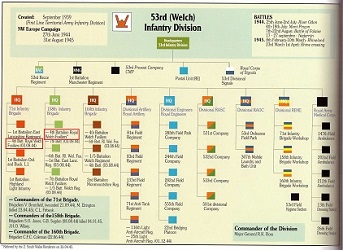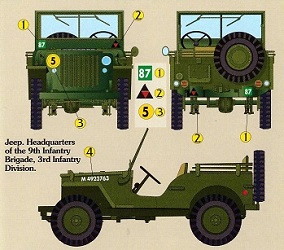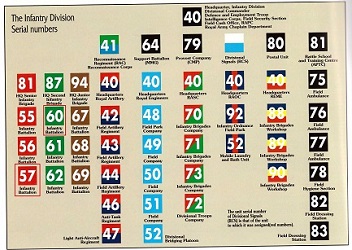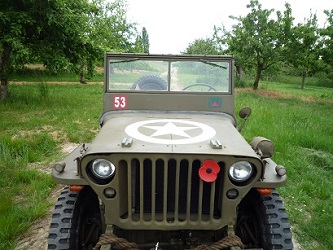Like I explained in the previous sections I wanted to restore the jeep like a jeep from the 53rd (welsh) divsion and particularly of the 4th battalion Royal Welsh Fusiliers,
since this batallion first entered Winterswijk and liberated it.
In a first step I tried to find out if there were any jeeps on battalion level or if they were only located e.g. on divisional level. A very good book about the british
armies are the books of Bouchier with two volumes about the british soldier. Volume 1 deals with uniforms, insignia and equiptments. Volume 2 discusses organisations,
armaments as well as tanks and vehicles. In Volume 2 the following graphic is included.
The diagram reveals that in a normal infantry battalion several jeeps were included. In particular, the battalion-jeeps were assigned to the battalion headquaters,
signal platoon, administrative platoon, support company headquaters, pioneer platoon and to each of the four rifle company headquaters. Together with the Chaplain jeep,
all in all 13 jeeps were in use of an infantry battalion.
Starting from this point I tried to find out the correct markings for the jeep.
Up to 3rd August 1944 the 4th Battalion Royal Welch Fusiliers belonged to the 158th Infantry Brigade. Then "as a result of recent fighting [in Normandy] - particularly the 158th Brigade's
operations against Evrecy - it was decided to make certain adjustments of Battalions within Brigades of the Division. It was found that with three Battalions of one
Regiment in the same Brigade - as in the case of the 158th Brigadewith its three Battalions of Royal Welch Fusiliers - difficulties were experienced in providing
reinforcements in the event of heavy casualties. [...]" (Barc56, p.66). As part of this restructuring, the 4th R.W.F. were transferred to the 71st Infantry Brigade on
3rd August 1944.
In other words until 3rd August 1944 the 4th R.W.F. was the senior battalion in the second infantry brigade (158th) of the 53rd division.
On 3rd August 1944 the battalion moved up one step in hierarchy and became the junior battalion in the senior infantry brigade (71st) of the division.
Based on these informations I knew, where the 4th R.W.F. were placed in the hierarchy of the 53rd division.
In the next step I wanted to find out which vehicle markings were used for british units and where they were placed on the jeep.
Again the volume 2 of the books by Bouchery provides very interesting information about vehicle markings. Here it is stated, that in general two markings were applied
to vehicles, the formation sign and the unit serial numbers.
The formation sign "was painted on the front and the rear [of a vehicle] in a standard surface not exceeding 21.6 cm by 24.10 [cm]." (BoV203, p. 122). "According to the
regulations the unit serial numbers were placed on the front and the rear either as a 24.5 cm by 21.6 cm plate of painted steel, or painted directly on to the
bodywork.
Whatever their number, all divisions of the same type committed on the same front use identical markings, both for the background colour or for the unit serial numbers.
These figures were not connected in any way with the units number. They only indicated the type of arm of service the vehicle or the machine belonged to."
(BoV203, p.122).
In the book also several examples of vehicle markings are included. The subsequent picture shows such an example for the vehicle markings on an infantry
division jeep.
The picture reveals that on the front of a jeep the vehicle markings were placed on the windshield under the windows. Here the divisional marking was placed on the
driver side (No. 2 in the picture) and the Arms of service marking with the serial number on the passenger's side (No. 1 in the picture). There are also some examples where the markings were placed the other way around,
but the named layout seems to be the most frequently used one.
At the rear of a jeep the vehicle markings were placed on the bumperets. Again the divisional marking was placed on the driver side and the arms of service marking
on the passenger's side.
In the next step I had to find out the correct divisional and arms of service markings for the 4th battalion Royal Welsh Fusiliers.
Divisional marking
The divisional marking of the 53rd (welsh) Division was quite easy to identify. The following picture shows the emblem of the division.
There seem to be different meanings of the emblem. "[...] Designed by Major-General BT 'Swill-Tubs' Wilson, it was designed to represent a Bardic Crown" (http://www.jonathanhware.com). "The letter W stands for Wales where most of the units making up the division were recruited." (BoV103, p.68).
Arm of Service marking
Compared to the divisional marking, for me it was much harder to identify the arm of service marking of the 4th battalion Royal Welsh Fusiliers. During the initial
restauration I did not have all the information on this homepage. Therefore at that time I did not have any clue, what would be correct arm of service marking for the jeep.
At that time I had seen several jeeps on meetings with a red background for the arm of service marking. Also regarding the serial number I did not have any information,
what would be correct for the 4th R.W.F. Thus I thought it would be the number of the division. Therefore in a first step for the arm of service marking I decided to use
a white 53 on a red background. (this can be seen e.g. on the picture in section Home)
At a later point in time after some valuable help of good friends in the jeep community I got mor insight into the taxonomy of the arm of service markings.
The following diagram shows the serial numbers for the different parts of an Infantry Division like the 53rd division.
The serial numbers were identical for all infantry divisions. The specific number depends on the place of the unit within the hierarchy of the division.
From the table it becomes obvious, that until 3rd August 1944 (before the battalion was relocated from the 158th infantry brigade
to the 71st infantry brigade), the correct arms of service markings would have been a white 60 on a green background.
The Arm of service marking of the junior battalion in the senior infantry brigade was a
white 57 on a red background.
This Arms of service marking should be appropriate for a jeep of the 4th R.W.F. during the liberation of Winterswijk in March 1945, since the 4th R.W.F. had been
relocated to this position in the hierarchy of the 53rd division on 3rd August 1944.
The following pictures show the divisional and arms of service markings on the front and the rear of MB158963.






